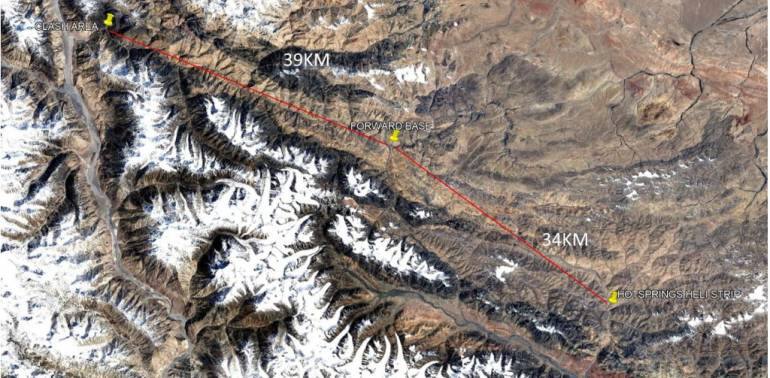Estimating Chinese Casualties In Galwan

Determining casualties through satellite imagery is very difficult. While changes in status quo are easy to plot, casualties involve rapid movement of ambulances and heli-borne medical evacuations, which happen rapidly, and can only be plotted through what has moved, and from where to where.
Moreover, the difference between casualties and fatalities is impossible to tell. However, going by the displacement of ambulances and helicopters on the Chinese side we get a widely variant ballpark figure from 16 to 96 casualties.
The Layout
The main areas of focus are marked below with yellow pins. Hotan to the north of the clash site and Ngari to the south are the main heliports servicing Chinese formations in the region. At Hot Springs, there is a solitary heli-strip. This is both to facilitate the supply of forward deployed forces as well as to facilitate helicopters plying between Hotan and Ngari, given the severe weight and range limitations of helicopters operating off these high-altitude bases.

For India, evacuation of casualties is a fairly simply process involving a 5-kilometre pullback to the Shyok Valley, which itself is 1.5 kilometre wide at this spot allowing large helicopters to land. Even on the rough road this would take 15-30 minutes to reach.
However, on the Chinese side, the closest evacuation point is 39 kilometres, as the crow flies (45 kilometres by road) and the nearest heli-strip is about 70 kilometres away. This would involve a gruelling drive of several hours on extremely winding mountain roads, before medical treatment is available and from there on a relatively straight road till a heli-strip for evacuation. This means we are looking at close to a 2-hour delay in critical treatment.
Helicopter Movement
The Chinese PLA is known to deploy several helicopter types here — from Russian Mi17s to Chinese-made Z8 and Z9s (both copies of European helicopters, the Super Frelon and the Dauphin, respectively) and even the Eurocopter EC-135. However, from June 10 to June 23 only Mi-17s could be observed. Surprisingly, they were only stationed at Hotan and despite fighters and troops being augmented, helicopter numbers were not. The total helicopters remained at four, and these, however, saw considerable to and fro movement.
The Casualty Figures
Going by six hourly satellite imagery, we can confirm at least eight sorties by the Mi-17s in Hotan. Despite range and weight limitations they can carry between eight to 12 severely wounded troops depending on the medical evacuation configuration chosen. It is highly unlikely that they were used to evacuate one soldier at a time, but it is also equally unlikely that they waited to fill up to 12 injured. Purely on averages it's best to go by four to eight casualties per helicopter. Also it is impossible to determine what their mission was, except radio frequency scanning confirms they did ply to the heli-strip near Galwan six times. If we assume all six of these trips were medical, this would mean a Chinese casualty figure (serious) of anywhere between 24 and 48.
What's more interesting, however, are truck movements on the road.
On June 14 and 15 it’s hard to detect ambulances, but, by June 16, we can see at least 16 large ambulances leaving over a six-hour period. Again the same proviso applies. It is highly unlikely they evacuated one soldier at a time, but they are provisioned for between four and six, based on the length. This gives us a safe range of casualties between 16 and 96 going by extremes, but more likely between 48 and 64 by averages.
Note that these figures are for injuries. The deaths on the spot may have been additional to the figures cited above, being deemed non-essential for immediate evacuation. To note, no ambulances were observed at the heliports in Ngari or Hotan.
All up, based on imagery, predicting casualties is a highly fraught exercise with a large number of caveats built in. However, at the very least we can average between 48 and 64 of which between 24 and 48 were serious enough to require helicopter evacuation to better hospitals.
Indeed, the Chinese casualties assuming a one man, one ambulance, one helicopter could be as low as 16 with six badly injured, or in the worst case scenario of jam-packed ambulances and helicopters, 96 injured.



No comments:
Post a Comment